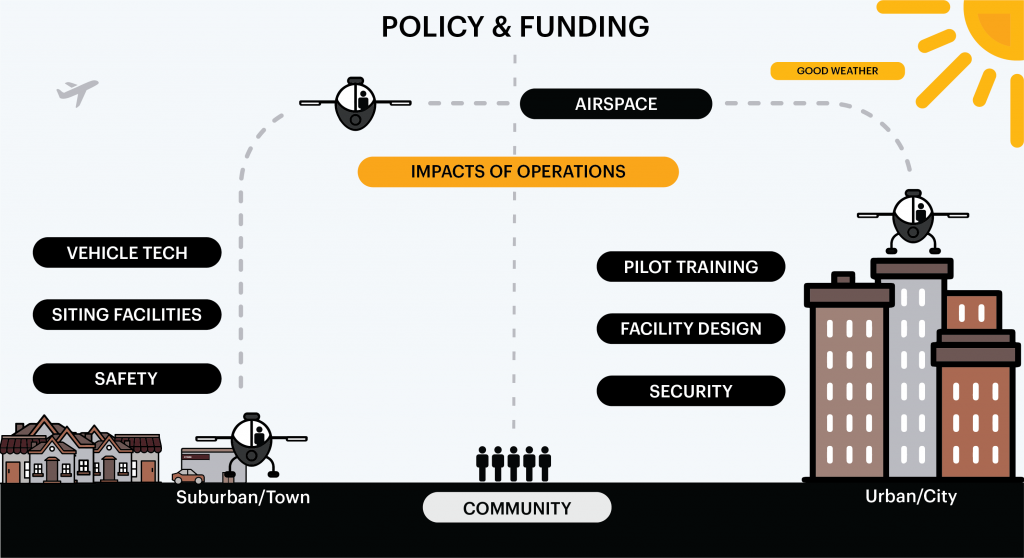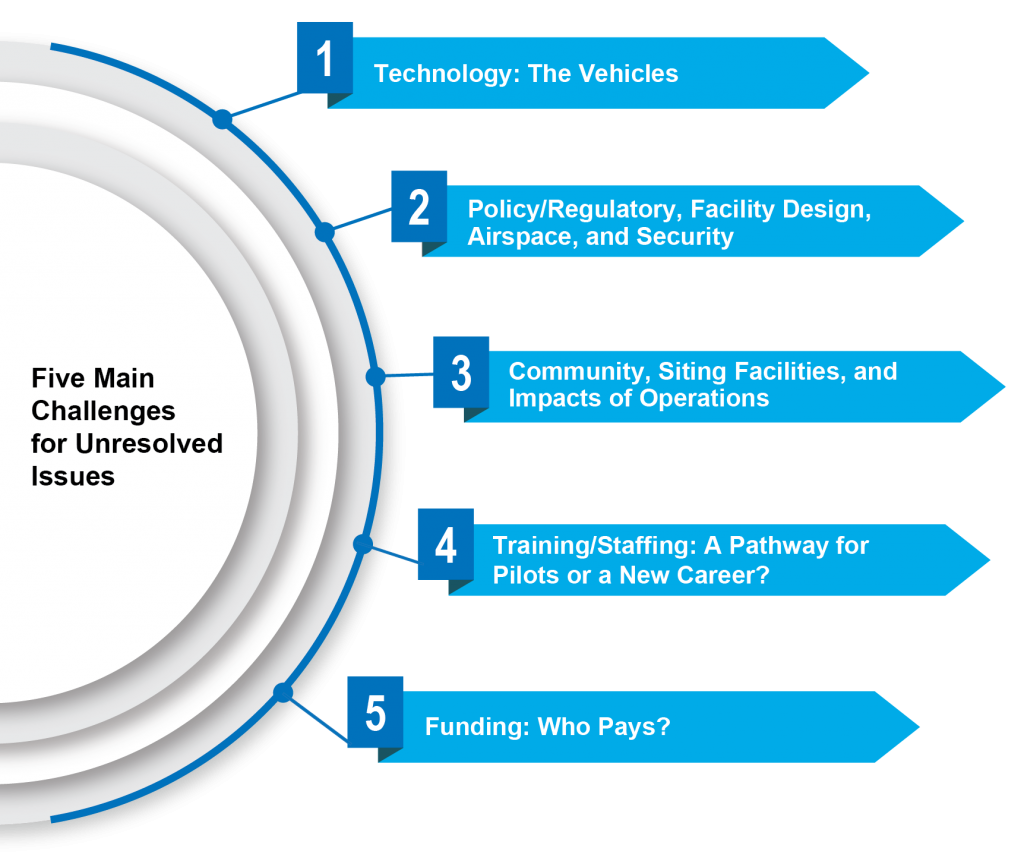Advanced Air Mobility
It’s Coming. What Obstacles Need to Be Surmounted Before It Arrives?
Written by: Ian Guy, Chris Runde, Richard Barone with contributions from Jeffrey Jackson, Christian Valdes, Jordan Roos, and Matt Lee
This LAB Brief is the second in a series on Advanced Air Mobility (AAM) which refers to the collective group of emerging aviation technologies that are anticipated to provide air transportation mobility options for people and cargo in local, urban, and regional environments. The focus of this Brief is on a broad range of AAM issues that will need to be addressed – specifically the five areas of vehicle technology, policy/regulatory issues, communities, training/staffing and funding. Future LAB Briefs will delve into other areas of AAM.
A key pioneer of flight, Alberto Santos-Dumont (1873 to 1932), had a vision of everyone having their own personal flying vehicle. He became known in Paris for his Baladeuse “Wanderer” one-man airship that he would secure to lampposts near his dining and drinking venues of choice. Over 100 years later, there is growing consensus that Advanced Air Mobility (AAM), specifically urban and regional electric Vertical Take-Off and Landing (eVTOL) 1 passenger services will happen and are just 5-10 years away. While not yet personal vehicles, they still are a major change in how mobility at airports and surrounding metropolitan areas will operate.

There are currently over 200 companies developing AAM vehicles. Many major international airlines are onboard either by providing financial backing to a vehicle developer or promising orders of vehicles. In addition, they are lobbying their governments to support AAM development efforts. At conferences, this new form of air mobility is front and centre of the agenda. Working groups and research teams on AAM are now commonplace at industry groups and academic organizations, such as the Transportation Research Board (TRB). Given that AAM is essentially now preordained, what major obstacles must still be surmounted before this exciting vision becomes a safe, reliable, and economically sound reality?
Many issues remain unresolved or only have partial answers. Uncertainties range from the current limited range of battery-powered vehicles to a common set of requirements for AAM facilities. Questions include:
- Will communities accept this new type of transportation service?
- How will the airspace be managed?
- Who will pay for the facilities and operation of the new network?
This is a partial list, but the variables can be organized into five main categories:
- Vehicle technology
- Policy/regulatory, Facility Design, Airspace, and Security
- Communities, Siting Facilities, and Impacts of Operations
- Training/staffing: a pathway for pilots or a new career?
- Funding – each of which deserves further scrutiny.

Technology: The Vehicles
AAM vehicle technology is rapidly advancing. However, there are so many players competing in the market that there is really no unified concept. Like the dawn of the automobile age, when companies were trying to determine what a prototypical car should look like, there are all different shapes, sizes and forms of eVTOL vehicles. With automobiles, over time, governments stepped in and began to mandate specific design elements to enhance safety, but most early innovations came from companies in the industry and were later adopted by all, either voluntarily or as required by regulation. AAM replicates those early days, and the industry has yet to fully determine what the baseline form factor and performance of eVTOL vehicles as a collective will be for future use.
Aside from their form factor, the performance of these vehicles will dictate the layout and scale of landing areas (vertiports) along with the design standards for facilities that support eVTOL vehicle operations. Vehicle designers face challenges in the following four areas that will influence the feasibility of AAM:
Range: Most eVTOL vehicles have a range of just 20-30 miles (33-50 Km), while there are some designers suggesting that their vehicles have a range as high as 130-180 miles (215-300 Km); their claims have not been fully demonstrated. Storage capacity and efficiency of current batteries drive range limits. For these reasons, several designers are exploring hybrid fueling alternatives, such as using a mix of batteries and conventional or hydrogen fuel. Hybrid fueling has the potential to substantially increase the range up to 400-500 miles (660 -830 Km).
Battery Charging Rates: Even with current rapid charging technology, which could result in an 80% charge in 20-30 minutes, this rate still limits the number of times a vehicle can fly per day and its range on each flight. Other options, such as swapping batteries, have their challenges. Vertiports must have separate spaces and provide equipment to change and charge batteries.
Capacity: Current designs for eVTOLs indicate a carrying capacity of anywhere from 4 to 8 passengers, which effectively limits their usage to provide a faster alternative to the car. If autonomously operated, the capacity of the vehicle could be increased with the removal of the pilot and associated cockpit avionics. However, many in the industry believe that customers will not easily accept autonomous operations and will insist on having a pilot, even if most of the vehicle operation is automated. In addition to the capacity of the vehicle and the vertiport including the number of landing, pads will also be a major factor. The number of pads might be limited by the site conditions and/or cost.
All-Weather Operations: eVTOL vehicles will initially operate under visual flight rules (VFR) or “see and avoid.” This will result in a grounding of eVTOL vehicles in instrument meteorological conditions (IMC) or bad weather. As these vehicles become more automated and operators gain experience, eVTOL vehicles should be able to operate under instrument flight rules (IFR) similarly to equipped helicopter flights of today.
When combined, the aforementioned issues will impact the level of service that the operators will be able to offer. If capacity is limited to up to 8 persons then aircraft ground times will have to be short, meaning battery recharge times of 20-30 minutes will not be acceptable. Also, as service frequency increases, the need for additional Vertiports sites needs to be explored, as queuing of aircraft will not likely be possible, especially in the urban context. If aircraft only have a short-range, then intraregional travel will be limited to only short trips, such as airport to the city center; eVTOL vehicles will not serve inter-regional markets.
While addressing these technological challenges will not be easy, most agree they are not insurmountable and will not be the main obstacles to the success of AAM services.
Policy/Regulatory, Facility Design, Airspace, and Security
If local, state, and national governments cannot agree on guidance for the design of facilities and management of eVTOL vehicle traffic, then the promises of AAM are unlikely to be successfully realized. In the end, AAM could just be a more advanced helicopter service with a niche market.
There are many issues that need to be decided upon, some of which include:
- Possible airspace managers could be the Air Navigation Service Provider (ANSP), local municipalities, or private operators. The Air Navigation Service Provider (ANSP e.g., FAA), local municipalities, or private operators? This is a big unknown at the moment. Fortunately, a solution will not be necessary until AAM reaches a threshold level of operations where air traffic management services become necessary. Until then, AAM will operate like helicopters do today. In a U.S. context, while there is interest in the local or private operation of the airspace, the FAA has yet to indicate whether it will relinquish its authority in this area.
- Should there be a common set of design standards to enable “common use” vertiport facilities? Currently, there is a desire for this but no requirement. Vehicle designers and vertiport development firms are teaming up to design facilities that will first and foremost support their team’s operation. Without clear guidance from regulators, there is the risk that we might have duplicative facilitates serving the same areas, similar to the history of railroads before common track gauges and unified “union” stations were adopted.
- Will all AAM passengers be required to pass through security screening? It is assumed that AAM service operating to/from the secure airside of an airport will require passengers to pass through security. However, the notion of screening all AAM passengers at all vertiports has also been raised. This would result in added facility and labor costs and varies from current helicopter operational practices. The primary benefit of using AAM is saving time. Requiring security screening of passengers degrades this benefit and reduces the value provided by AAM. However, screening passengers might improve safety and reduce risk. In determining the need for security screening at vertiports, governments should assess the potential safety risks to eVTOL vehicle passengers and surrounding communities. Not every facility/operation will carry the same risks as others. Population density along with the extent of the service should be some of the factors considered in this assessment.
These three issues are just a sampling of the questions that will require answers. It is also clear that environmental policy and regulatory review processes for AAM will operate in will trigger the need for regulation for community engagement and mitigation measures.
Communities, Siting Facilities, and Impacts of Operations
Engaging communities will be critical to the success of implementing new AAM services. Communities are likely to be sensitive to the following:
- Traffic concerns include the siting of Vertiports due to eVTOL air operations and ground-based trip generation
- Noise, safety, and privacy concerns including overhead operations of eVTOL vehicles on defined and ad-hoc routes
- Equitability concerns include the accessibility of service and the proximation and affordability for the broad public and not just the privileged
While these broad concerns can be viewed in a negative light, each implementation of AAM brings the benefits of new jobs and improved access and economic development opportunities. We are at the cusp of a new type of mobility similar to the emergence of the train and automobile industries that came before. Luckily, we have the benefit from learning from those historic transformations both in-process and public behavior and applying these experiences to AAM. Community acceptance will only come once the impacts of eVTOL vehicles are demonstrated to be far less severe than conventional helicopter operations. Current research has demonstrated that helicopters produce substantially more noise than eVTOL vehicles that are currently in development. Local exhaust emissions, another impact of helicopter operation, are non-existent in battery and hydrogen-powered eVTOL vehicles. The reduction of noise and elimination of local emissions should make community acceptance of eVTOL vehicles easier. A first step in proofing this out could be to introduce purpose-built emergency service eVTOL vehicles to demonstrate their noise and emissions advantage over conventional helicopters. Another step could be to study the non-acoustic factors that impact those near eVTOL vehicle operations. Even though eVTOL vehicles are expected to produce less environmental impacts compared to helicopters, other factors including safety, equity, and privacy will influence the community’s acceptance. Acoustic and non-acoustic annoyance studies need to be conducted for this classification of vehicles to best understand public perception and impacts.
Training/Staffing, A Pathway for Pilots or a New Career?
AAM services will initially require pilots. While there are aspirations to fully automate the vehicles as the technology matures, there are those that argue pilotless eVTOL vehicles will never materialize due to the perception of safety factors that a pilot’s presence provides to a customer.
The aviation industry is currently suffering from a pilot shortage. The hope is by the time AAM services are introduced over the next decade the pilot shortage will ease and eVTOL vehicles could serve as an entry-level job for pilots wanting a career with larger commercial carriers. Others disagree, seeing the career of an eVTOL vehicle pilot as very different from a commercial airline aviator. eVTOL vehicles are sufficiently different from an aircraft to make the skills gained from flying eVTOL vehicles not transferable to commercial aircraft.
Training requirements for piloting eVTOL regular vehicles have the potential for being far less than for commercial aircraft as much of the operation of the vehicles will be automated, and they will initially only be operated in VFR conditions. These two factors seem to indicate that for the majority of prospective eVTOL vehicle pilots, this will be a new career. Many will not see it as a pathway to larger commercial passenger airlines. Many will prefer to remain local and not travel, the barriers to entry are likely to be less as well with far less rigorous training requirements and costs, which are typically incurred by the pilot.
Funding: Who Pays?
New infrastructure underpins and supports the growth of new modes of travel. This was the case with automobiles and aircraft, which required roads and airfields, parking lots, and terminals. In the early days of both, entrepreneurs filled some of these needs from the early airfields to toll roads, but over time government stepped in to help scale things up and make these new forms of travel accessible to more of the public.
Currently, private sector actors are taking various approaches:
- Some are vertically integrated (think Apple) and trying to do it all.
- Some are focused on a piece of the puzzle, whether it is the vehicle or vertiport.
- Some are teaming up to try to provide integrated solutions and search for investors to provide capital.
Airports are of two minds where some are aggressively pursuing funding and partnerships for this effort, while others see it as a conflict with their operations and own agendas. Those who view this as an opportunity for new growth are using this as a way to proactively plan for new facilities and how service routes might be impacted. Those who see this as a burden may not want to incur additional costs to support the required infrastructure needed to accommodate this new growth. Airports may be open to private sector partnerships, similar to privately owned and operated passenger terminals at some airports. These private partnerships would assume the capital and operating burdens of the service.
The current state of play in the U.S. has federal and state governments beginning to provide support to plan for these services. In November of 2021, the House of Representatives passed legislation called the Advanced Air Mobility Coordination and Leadership Act in order to direct the U.S. Department of Transportation (DOT) to create an AAM inter-agency working group. This group would be responsible to “…plan and coordinate efforts related to the safety, infrastructure, physical security, cybersecurity, and federal investment necessary to bolster the AAM ecosystem in the United States.” If the law is enacted (the Senate Commerce Committee has passed similar legislation), the interagency working group would need to be stood up within 120 days. 2
The Outlook
AAM is on its way, but how it will arrive and the exact form is still unclear. It is our view that the biggest obstacles will arise from public perception and attitudes. We believe that unless people can answer “yes” to the following questions, then adoption will be more limited.
For those flying:
- Can I fly between places that suit me?
- Does the price I am paying a good value?
- Do I feel safe knowing the pilot has been on the job for weeks or that there is no pilot at all?
- Is the price I am paying good value?
- Am I helping the environment?
For those on the ground:
- Am I confident about the safety of “flying taxis” over my head?
- Does the noise make almost no difference to my home/work environment?
- Does being close to a vertiport improve my area?
- Is the noise tolerable?
The Government along with safety and security policies and regulations will provide a framework that enables AAM; the prize of modernization is too great not to explore. The hope is that regulation will be dynamic and responsive as the market develops.
“I thought of the time, sure to come, when owners of handy little air-ships will not be obliged to land in the street but will have their … own roof-gardens. But such roof-gardens must be broad and unencumbered.”
– Alberto Santos-Dumont 3
At L&B, we foresee AAM as a valuable step on the way to achieving Santos-Dumont’s vision and look forward to continuing to work with the public, governmental entities, and stakeholders to ensure the exciting future of flight continues to enhance the world in aviation for the benefit of us all.
1 Another vehicle configuration that is being promoted for Regional Air Mobility is electric Short Take-Off and Landing (eSTOL) aircraft. While L&B recognizes these aircraft as another credible alternative, for the sake of brevity eSTOL will not be covered in this article.
2 https://dronedj.com/2021/11/09/house-passes-advanced-air-mobility-coordination-bill/
https://www.ainonline.com/aviation-news/business-aviation/2021-11-05/us-house-passes-advanced-air-mobility-bill
3 “Wings of Madness” by Paul Hoffman, Published by Hyperion 2003.
What is the L&B LAB?
The LAB is Landrum & Brown’s research and development unit. Our mission is to harness decades worth of industry knowledge and expertise to develop innovative solutions that support our clients along with promoting industry thought leadership.
This document was prepared by Landrum & Brown, Inc. | [email protected]
Sign up to receive our next L&B LAB in your inbox!




